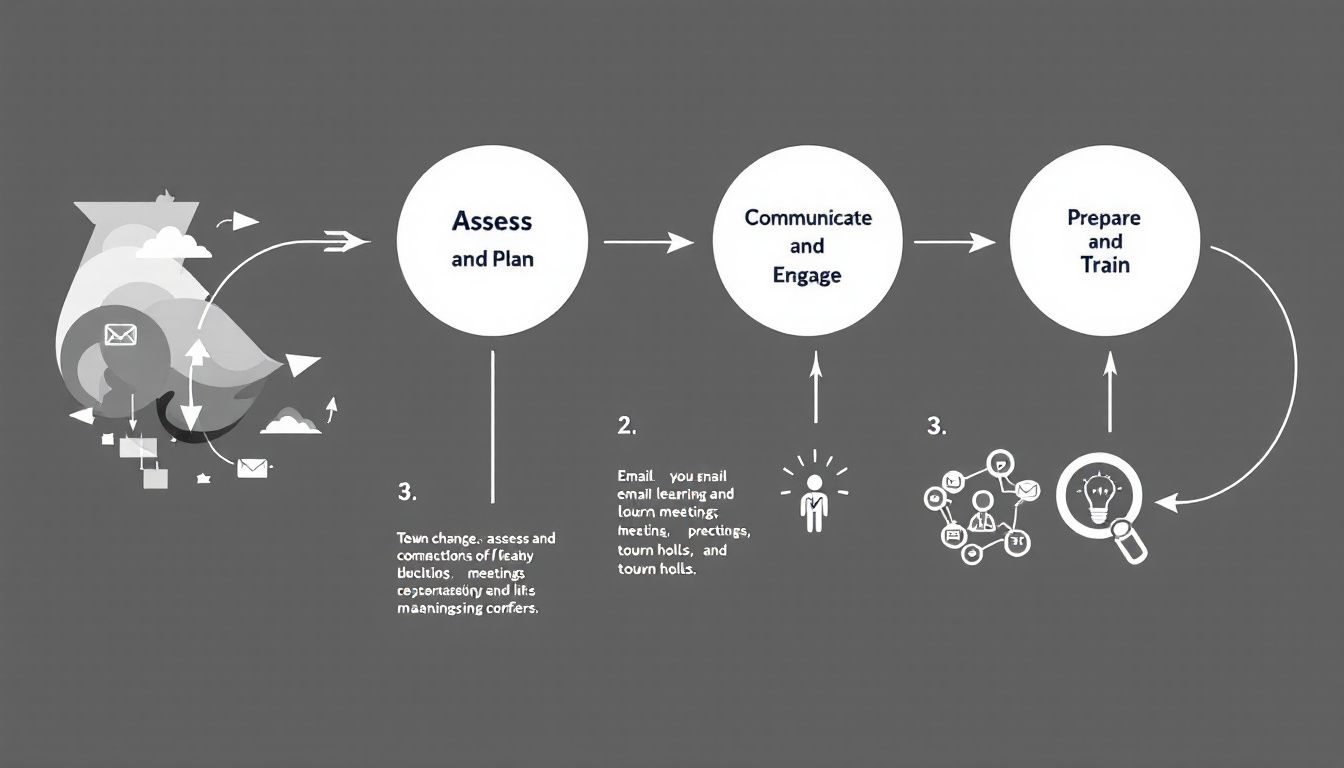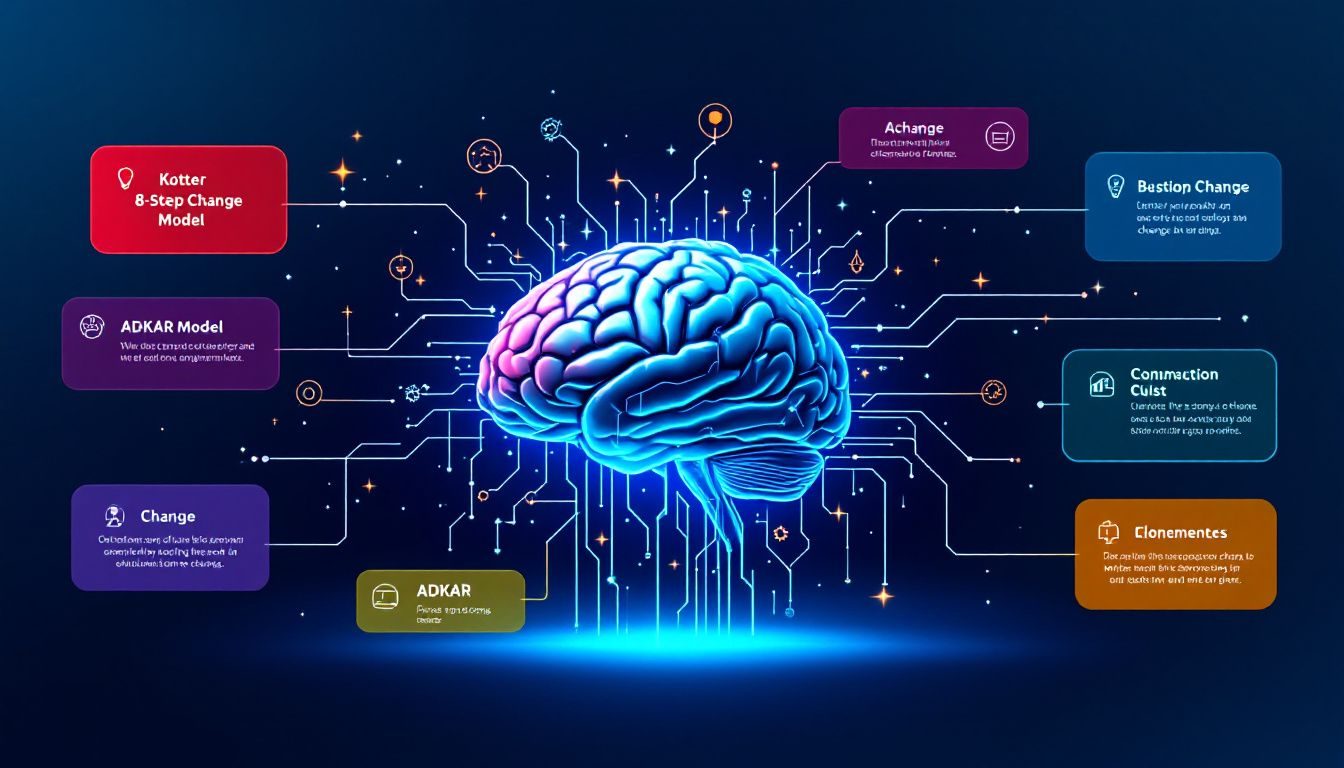Change management guides organizations through transitions by planning, implementing, and reinforcing changes to reduce resistance and boost engagement. In this article, you’ll discover actionable strategies and steps for effective change management, helping your organization adapt successfully.
Key Takeaways
- Change management involves a systematic approach to help organizations effectively transition and ensure sustainable changes, emphasizing planning, implementation, and monitoring.
- Key strategies for successful change management include setting clear goals, transparent communication, and engaging employees to foster ownership and commitment.
- Leadership plays a critical role in change management by demonstrating commitment, empowering teams, and providing continuous support to navigate transitions effectively.
Understanding Change Management

Change management involves a systematic method for helping individuals, teams, and organizations make transitions. It aims to move them from their present situation to a desired future condition. This process is not just about making changes but ensuring that these changes are effective and sustainable. Effective change management professionals enhance employee engagement and preparedness during organizational change management transitions, thus minimizing resistance and maximizing alignment with new directions. Developing change management skills is essential for navigating these transitions successfully.
The benefits of change management are multifaceted. Organizations with robust change management practices can expect higher success rates and lower costs related to project failures. A structured framework for managing change can significantly improve project outcomes and return on investment. During the digital transformation era, change management processes have become more responsive, allowing organizations to adapt swiftly to changing needs.
At its core, change management involves planning, implementing, and solidifying changes to ensure long-term and effective transitions. This comprehensive approach helps organizations implement, monitor, and report on change success, ensuring they remain competitive and adaptable. Minimizing resistance and maximizing employee engagement fosters a process-driven culture where new roles and responsibilities are understood and embraced.
The Change Management Process

The change management process is a systematic approach that comprises several key steps, each crucial for ensuring a smooth transition. These steps typically include:
- Identifying the need for change
- Planning
- Implementing
- Monitoring
- Reinforcing changes
While the specific steps may vary depending on the change initiative, the overall process remains consistent in its goal to manage change effectively.
A successful change management process starts with a systematic diagnosis, assessing the current situation to determine the need and capability for change. Starting conditions, often referred to as point A, are defined to establish a baseline from which progress can be measured.
A well-defined change management plan serves as a structured blueprint to guide the transition while minimizing resistance and ensuring that the organizational changes are effectively embedded into the organizational culture to implement change.
Preparing for Change
Preparing for change involves several strategic, social, and technical components that are crucial for understanding the transition process. A clear strategic vision and strategy act as a roadmap for change, aligning resources effectively and ensuring that everyone understands the direction and purpose of the change. Identifying the change involves clearly defining what needs to change and assessing its impact across the organization.
The initial goal during this phase is to raise awareness among employees, which helps gain their buy-in and reduce resistance to the change. Managers play a vital role in helping employees recognize and understand the need for change. Early establishment of change leaders provides guidance and facilitation throughout the transition.
Avoiding common pitfalls, such as failing to set clear goals, is essential for a successful change management strategy.
Crafting a Change Plan
Crafting a change plan is a critical step in the change management process. This plan must include clear objectives, the content of the changes, and the overall process of change. It should outline when, how, and why the changes will occur, including specific tasks and responsibilities for team members.
Thorough and strategic details are essential to ensure clarity and direction. The change management plan should clearly outline the objectives, timeline, and responsibilities for executing the change. Factors such as the size of the change, the number of people impacted, the risk involved, and available IT resources determine the implementation method for a change.
Following these outlined steps is crucial for a successful implementation process.
Implementing Change
Implementing change requires effective communication of the organization’s vision. It is critical to communicate repeatedly during this phase to ensure that everyone understands the purpose and direction of the change. Change managers should empower employees during the implementation process by providing the necessary tools and support for success.
Celebrating short-term wins is essential for maintaining momentum and keeping morale high during the change process. It is also important to anticipate and mitigate potential roadblocks during the implementation of change. Addressing these challenges proactively ensures a smoother transition and increases the likelihood of successful change management.
Embedding Changes
To ensure sustainability, new changes must be integrated into both training programs and organizational culture. This integration helps solidify the new processes and practices as the new standard, often referred to as the ‘refreeze’ stage in Lewin’s model.
Embedding changes in this manner helps organizations prevent reversion to old habits and maintain new ways of working over the long term.
Reviewing Progress
Conducting a review of progress after a change initiative provides valuable insights for future improvements and strategies. During this review process, it is crucial to ask questions such as: Were project goals met? Can success be replicated? What went wrong if not? Employing the PDCA (Plan-Do-Check-Act) cycle promotes ongoing progress and helps fix underlying issues within the organization.
The PDCA model emphasizes the importance of maintaining momentum throughout the change process to ensure lasting change. Regularly reviewing progress and making necessary adjustments helps organizations ensure their change initiatives are on track and promptly address any issues, leading to continuous improvement and successful change management.
Key Change Management Strategies

Key change management strategies are essential for guiding the change process and ensuring its success. These strategies include establishing clear goals, transparent communication, and employee participation. By defining specific objectives and aligning them with the overall business strategy, organizations can provide direction and focus for all change efforts.
Change management models serve as frameworks that help organizations successfully implement and navigate changes. Learning about popular change management model enables businesses to adopt best practices for effective change implementation.
Effective leaders foster support and reduce resistance by clearly communicating the necessity and benefits of change to stakeholders.
Establish Clear Goals
Defining specific objectives is crucial for guiding the change process and measuring success. Goals are essential in change management as they provide direction and focus for all efforts. Effective goals are characterized by the SMART criteria: Specific, Measurable, Achievable, Relevant, and Time-bound.
Measurable goals allow for evaluation of progress and success in the change initiative.
Transparent Communication
Open communication reduces resistance and fosters trust during change initiatives. Clearly communicating the reasons for change and its impact on individuals is essential for success. Managers should avoid sugarcoating and promising unrealistic outcomes when communicating about change. A multi-channel approach is crucial in communicating change across the organization.
Effective change management tools provide a centralized platform for sharing updates and documents. Project management tools like Trello and Asana facilitate real-time task assignments and progress monitoring during change initiatives. Leaders should explain the reasons for change, hold meetings, and invite discussions to facilitate communication.
Regular discussions with front-line workers about current challenges and support needed during change are important.
Employee Participation
Engaging employees early in the change management process fosters their support and reduces potential resistance. Engaging employees in the change process cultivates ownership and commitment. Encouraging team members to take initiative helps build trust and commitment during transitions.
The ADKAR model emphasizes the importance of employee participation to foster awareness and desire for change.
Popular Change Management Models

Change management models are theories and concepts. They provide methodologies that guide successful change. The purpose of these models is to provide guiding principles that align proposed changes with the necessary tools. Following these models is crucial for successful implementation and to avoid failure. Sustained acceleration in change management is important to maintain momentum and enthusiasm during the transition.
Popular models include the ADKAR Model, Kotter’s 8-Step Model, and Lewin’s Change Theory. The ADKAR Model and Enhanced Kotter’s 8-Step Change Model are beneficial for processes and systems changes. Lean Change Management, developed by Jason Little, draws inspiration from Lean Startup, Agile, and Design Thinking. Understanding these models enables businesses to adopt best practices for effective change implementation.
ADKAR Model
The ADKAR Model was created by Jeff Hiatt and stands for Awareness, Desire, Knowledge, Ability, and Reinforcement. This model is non-linear, meaning changes can occur simultaneously across its five goals. Success at each milestone of the ADKAR Model is determined using a 1-5 scale, with a barrier point defined as a score of three or below on a milestone.
The key outcomes of the ADKAR Model are:
- Build awareness of the need for change
- Create a desire to participate and support the change
- Provide knowledge on how to change
- Develop the ability to implement the change
- Reinforce the change to sustain it
By focusing on these outcomes, organizations can ensure a holistic approach to change management.
Kotter’s 8-Step Model
John P. Kotter is considered the most influential expert in change management. His 8-Step Model provides a structured approach to change, which includes creating a sense of urgency, forming a powerful coalition, creating a vision for change, communicating the vision, empowering others to act, creating quick wins, building on the change, and anchoring the changes in corporate culture.
Lewin’s Change Theory
Kurt Lewin developed a foundational 3-step change model that is crucial to understanding change management. Lewin’s change model consists of three key stages: unfreeze, change, and refreeze, which guide the transition process.
These stages were effectively implemented by a Vietnamese university, resulting in increased student satisfaction through improved teaching methods and enhanced feedback mechanisms.
Overcoming Resistance to Change
Resistance to change can manifest in various ways, including decreased productivity and increased employee turnover. People are often resistant to change due to discomfort with new ways. Neglecting the people affected by change is a common reason for the failure of some change strategies. Well-thought-out change management helps overcome resistance and prevents wasting time and money.
Ten methods proposed by Morten T. Hansen can help overcome resistance to change. Collecting employee feedback in change projects improves transition processes and ensures desired business outcomes. By recognizing early signs of resistance, organizations can address issues effectively and facilitate smoother transitions.
Identifying Resistance
Recognizing early signs of employee discomfort can help address resistance effectively. Regularly gathering employee feedback during the change process can help identify issues early and facilitate smoother transitions. Feedback mechanisms such as surveys should be utilized to gather insights during the change process.
Regular feedback from team members aids in refining the change management process and addressing any emerging issues.
Addressing Concerns
To address fears and uncertainties that may arise during the change, it is crucial to recognize employee concerns in change management. Involving employees in decision-making enhances their commitment to the change process and helps address their specific concerns. Encouraging employee feedback during the change process can identify potential issues and enhance buy-in.
Engaging with employees directly to understand their fears is crucial for effective change management. Monitoring progress after implementing changes allows for timely adjustments, which enhances the overall success of the initiative. Improvement of the change management process is achieved by consistently tracking and analyzing each step.
Building Support
Establishing a network of change agents within the organization enhances support for change initiatives. These change agents can communicate the benefits of the change, address concerns, and provide ongoing support to their peers.
By building a strong support network, organizations can foster a positive environment that encourages acceptance and commitment to the change process.
The Role of Leadership in Change Management

Effective leadership commitment is crucial for successful change initiatives, ensuring support and direction throughout the process. A transparent approach to communication reduces uncertainty and builds trust within the organization, which is essential during transitions. Leaders should demonstrate qualities like strategic thinking, flexibility, and dependability to effectively lead during change.
Leaders must understand the change management process to guide team members smoothly through transitions. Leading by example, empowering teams, and providing continuous support significantly influence the success of organizational change initiatives.
Leading by Example
Leaders demonstrating commitment can inspire their teams to embrace change. Commitment from leadership fosters a positive environment where change can thrive. Adaptability allows leaders to respond effectively to unexpected challenges during change. Leaders who model adaptability set a standard for their teams, encouraging a culture of flexibility.
Effective leadership can mitigate resistance and build momentum during change initiatives. Leaders’ actions and attitudes greatly influence organizational culture and employee engagement. By leading by example, leaders can instill confidence and buy-in from their teams.
Empowering Teams
Embedding changes within company culture and practices is necessary to prevent reversion to the prior state after a change initiative. Think about implementing new organizational structures and controls. Additionally, create reward systems to ensure that changes are maintained. Aligning team objectives with the overarching vision of change enhances understanding and support among team members.
Change agents have important responsibilities in sharing news about changes. They also highlight successes and engage in discussions regarding issues with end-users.
Continuous Support
Leadership support is essential for successful transitions, as it sets the tone for the entire organization. Leaders should demonstrate commitment and adaptability, leading by example to reassure employees. Empowering teams involves encouraging employees to take ownership of the change process, fostering accountability.
Involving employees fosters greater engagement and opens up diverse perspectives during the change process.
Tools and Technologies for Change Management
Tools and technologies play a pivotal role in facilitating change management processes. Commonly used tools include spreadsheets, graph charts, flowcharts, and software suites. Whatfix, for instance, offers contextual guidance, workflow support, user analytics, hands-on training simulations, and real-time feedback for effective change management. Creating simulated IT environments, Whatfix enables training without impacting real application data.
Effective change management requires a structured approach, incorporating planning, communication, and employee engagement. Data analytics can pinpoint effective strategies and reveal areas needing improvement post-change implementation. Contextual in-app help significantly contributes to employee performance during change.
Project Management Tools
Project management tools are essential for optimizing the change management process by providing a structured approach to tracking progress and facilitating collaboration. These tools improve visibility into project status, enhance team communication, and support effective resource allocation.
Popular project management tools include Trello, Asana, and Jira, which offer features tailored for monitoring tasks and managing team workflows. Utilizing these tools ensures that all team members are aligned on objectives and can contribute effectively to the change initiatives.
Digital Adoption Platforms
Whatfix DAP helps organizations provide live, interactive end-user training. Digital adoption platforms significantly ease the transition for employees by integrating training directly within the applications they use. These platforms offer in-app tutorials and tooltips to guide employees through new software and processes, making the adoption of new technologies smoother and more efficient.
Data Analytics and AI
Data analytics and AI enhance change management effectiveness by providing insights for planning, execution, and evaluation. By leveraging data analytics, organizations can identify areas needing change and prioritize initiatives based on their potential impact.
These technologies enable real-time tracking of key performance indicators, allowing for informed decision-making and continuous improvement throughout the change process.
Measuring Success in Change Management
Measuring the success of change initiatives is crucial for understanding their impact and making necessary adjustments. Key performance indicators (KPIs) are essential for evaluating the impact of change management efforts. Effective metrics are essential to gauge the success of change initiatives, as they guide adjustments and ensure alignment with desired outcomes.
Data analytics tools can help organizations track key performance indicators, thus enabling informed decision-making during change processes. By utilizing these tools, organizations can ensure that their change strategies are effective and aligned with their overall goals.
Setting KPIs
Developing KPIs should align with the specific objectives of the change initiative. KPIs must be specific and measurable to effectively assess the success of change initiatives. Stakeholder satisfaction is a crucial metric for evaluating the success of change initiatives.
Analyzing change management metrics can reveal areas that require adjustments to improve future initiatives.
Tracking Progress
Monitoring and measuring during the change process is vital as it ensures smooth implementation and allows for the prompt addressing of problems. Key stakeholders provide essential feedback and gauge perceptions, enhancing the effectiveness of the monitoring process.
Regularly assessing metrics allows organizations to quickly identify and rectify any issues that arise during the change process. Using real-time dashboards can enhance the monitoring of change initiative metrics.
Analyzing Results
Post-implementation analysis should involve all stakeholders to ensure a comprehensive understanding of what worked and what needs improvement. Data analytics and AI provide insights during the evaluation phase to assess the success of initiatives, highlighting effective strategies and areas needing improvement.
Utilizing both stakeholder feedback and data insights enables organizations to effectively identify successes and areas for improvement in their change initiatives.
Building a Change Management Plan
A plan for implementing changes and solidifying them as the new norm is essential for managing organizational change. The purpose of a change management plan is to guide through the transition process. Building a change management plan involves six key steps, including defining success criteria and KPIs to ensure successful change management. Change management software supports the change process with tools for training, tracking progress, and creating knowledge bases.
Setting and monitoring change KPIs can lead to a success rate that is 7.3 times higher. Utilizing templates can help organize various components of a change management plan, facilitating smoother transitions. By following a structured approach, organizations can ensure that their change management efforts are effective and sustainable.
Summary
Mastering change management is essential for navigating the complexities of modern business. By understanding the change management process, implementing key strategies, leveraging popular models, and utilizing the right tools and technologies, organizations can ensure successful transitions. Effective change management minimizes resistance, maximizes employee engagement, and aligns the organization with its future state.
In conclusion, the journey of change management is continuous, requiring constant monitoring, evaluation, and adaptation. By building a comprehensive change management plan and fostering a culture of change, organizations can stay competitive and resilient in an ever-evolving landscape. Embrace change as an opportunity for growth and innovation, and lead your organization towards a successful future.
Frequently Asked Questions
What is change management?
Change management is a structured process that facilitates the transition of individuals, teams, and organizations from their current state to a desired future state. It encompasses planning, implementing, and solidifying changes for effective long-term outcomes.
Why is change management important?
Change management is crucial as it enhances employee engagement and minimizes resistance, ensuring organizations remain competitive and adaptable. By effectively implementing and monitoring change, organizations can achieve greater success in their initiatives.
What are the key steps in the change management process?
The key steps in the change management process include identifying the need for change, planning, implementing, monitoring, and reinforcing the changes. A systematic diagnosis and a well-defined plan are essential for ensuring successful transitions.
How can organizations overcome resistance to change?
Organizations can effectively overcome resistance to change by proactively acknowledging discomfort, soliciting employee feedback, addressing concerns, and establishing a network of change agents. This approach fosters a collaborative environment that supports successful change initiatives.
What role do leaders play in change management?
Leaders are essential in change management as they demonstrate commitment, inspire through example, empower teams, and provide continuous support, all of which are crucial for successful change initiatives. Their active engagement ensures a smoother transition and fosters a positive environment for adaptation.
